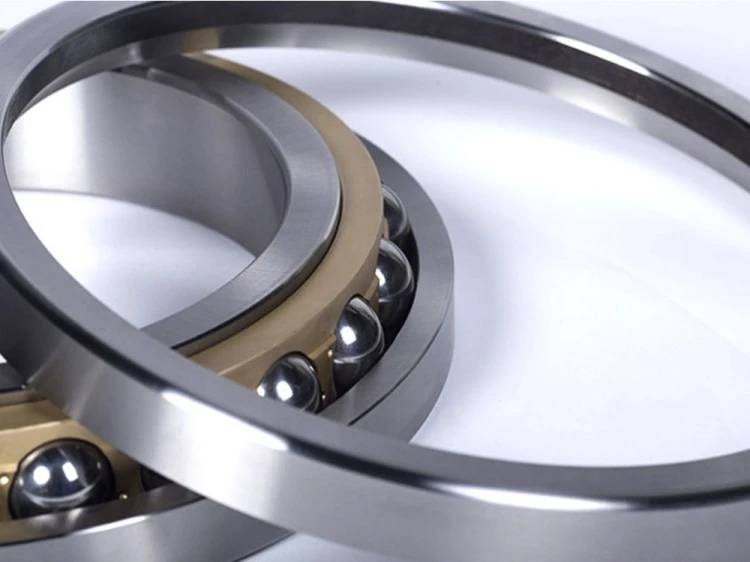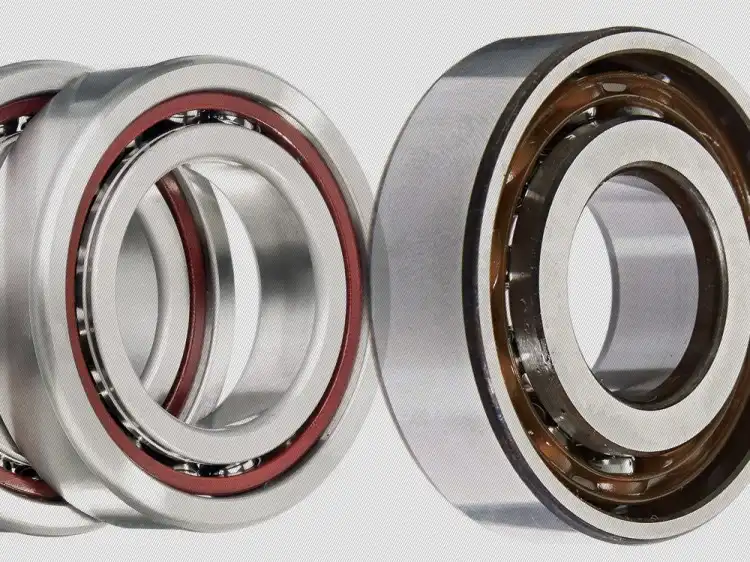What is the Preload in a 4 Point Contact Ball Bearing?
Preload is a crucial design parameter in 4 point contact ball bearings that significantly influences their performance and reliability. This fundamental concept involves applying a predetermined force to eliminate internal clearances and establish optimal contact between the bearing's rolling elements and raceways. Understanding preload in 4 point contact ball bearings is essential for engineers and technicians working with precision machinery, as it directly impacts bearing stiffness, accuracy, and service life.

How does preload affect the performance of 4 point contact ball bearings?
Impact on Bearing Stiffness
The preload in 4 point contact ball bearings plays a vital role in determining bearing stiffness. When proper preload is applied, it eliminates internal clearances and creates a controlled contact pressure between the balls and raceways. This enhanced contact results in increased bearing stiffness, which is particularly important in applications requiring high precision and stability. The 4 point contact ball bearing's unique design allows for superior axial and radial load capacity compared to conventional ball bearings. Higher stiffness achieved through correct preload helps minimize deflection under load, resulting in more precise shaft positioning and improved machine tool accuracy.
Effect on Operating Temperature
Preload significantly influences the operating temperature of 4 point contact ball bearings. The applied preload creates additional friction within the bearing, which generates heat during operation. While some preload is necessary for optimal performance, excessive preload can lead to increased heat generation and higher operating temperatures. The 4 point contact ball bearing's design allows for better heat dissipation compared to other bearing types, but proper preload management remains crucial. Engineers must carefully balance the need for stiffness against the potential for heat generation to ensure optimal bearing performance and longevity.
Influence on Bearing Life
The relationship between preload and bearing life in 4 point contact ball bearings is complex and multifaceted. Appropriate preload can extend bearing life by ensuring proper load distribution and minimizing vibration. However, excessive preload can significantly reduce bearing life by increasing internal stresses and accelerating wear. The unique four-point contact design provides better load distribution capabilities, but this advantage can only be fully realized with correct preload settings. Regular monitoring and maintenance of preload conditions help ensure optimal bearing performance throughout its service life.
What factors determine the optimal preload in 4 point contact ball bearings?

Operating Conditions
The selection of optimal preload for 4 point contact ball bearings depends heavily on the specific operating conditions of the application. Factors such as speed, load magnitude, load direction, and environmental conditions all play crucial roles in determining the appropriate preload value. High-speed applications typically require different preload settings compared to low-speed operations, as centrifugal forces and thermal effects become more significant at higher speeds. The 4 point contact ball bearing's ability to handle combined loads makes it particularly sensitive to operating condition changes, requiring careful consideration during preload selection.
Mounting Configuration
The mounting arrangement significantly influences the optimal preload setting for 4 point contact ball bearings. Different mounting configurations, such as back-to-back, face-to-face, or tandem arrangements, require different preload values to achieve optimal performance. The mounting system's rigidity, thermal characteristics, and alignment accuracy all affect how the preload is maintained during operation. Proper consideration of these factors ensures that the 4 point contact ball bearing maintains its intended preload throughout its service life.
Material Properties
The mechanical and thermal properties of bearing components play a crucial role in determining optimal preload values. Different materials exhibit varying thermal expansion coefficients and elastic properties, which affect how the bearing responds to preload forces. The 4 point contact ball bearing's unique design requires special attention to material selection and properties to ensure consistent preload maintenance under various operating conditions. Understanding these material characteristics helps engineers select appropriate preload values that account for thermal expansion and elastic deformation during operation.
What methods are used to achieve and maintain preload in 4 point contact ball bearings?

Mechanical Preload Methods
Various mechanical methods are employed to achieve and maintain preload in 4 point contact ball bearings. These include spring preloading, spacer ring preloading, and adjustable nut systems. Each method has its advantages and limitations, making them suitable for different applications. The 4 point contact ball bearing's design allows for more precise preload control compared to conventional bearings, but proper implementation of these mechanical methods is crucial for optimal performance. Regular inspection and adjustment of mechanical preload systems help ensure consistent bearing operation.
Thermal Preload Considerations
Temperature changes during operation can significantly affect preload in 4 point contact ball bearings. Thermal expansion of bearing components can either increase or decrease the initial preload, depending on the mounting configuration and materials used. Engineers must account for these thermal effects when designing preload systems, often incorporating temperature compensation mechanisms. The 4 point contact ball bearing's superior heat management capabilities help maintain more stable preload conditions, but careful consideration of thermal effects remains essential.
Monitoring and Adjustment Techniques
Modern bearing installations often incorporate sophisticated monitoring systems to track preload conditions in 4 point contact ball bearings. These systems may include temperature sensors, vibration monitors, and displacement sensors to provide real-time feedback about bearing performance. Regular monitoring helps identify when preload adjustments are necessary, preventing both under-preload and over-preload conditions. The 4 point contact ball bearing's design facilitates more accurate monitoring of operating conditions, enabling better preload maintenance throughout the bearing's service life.
Conclusion
Understanding and properly managing preload in 4 point contact ball bearings is crucial for optimal performance and longevity. Through careful consideration of operating conditions, mounting configurations, and material properties, engineers can select and maintain appropriate preload values. Regular monitoring and adjustment ensure consistent bearing performance, while advanced preload methods help maintain optimal conditions throughout operation. The unique design of 4 point contact ball bearings offers superior performance capabilities when properly preloaded.
Luoyang Huigong Bearing Technology Co., Ltd. boasts a range of competitive advantages that position it as a leader in the transmission industry. Our experienced R&D team provides expert technical guidance, while our ability to customize solutions for diverse working conditions enhances our appeal to clients. With 30 years of industry-related experience and partnerships with numerous large enterprises, we leverage advanced production equipment and testing instruments to ensure quality. Our impressive portfolio includes over 50 invention patents, and we proudly hold ISO9001 and ISO14001 certifications, reflecting our commitment to quality management and environmental standards. Recognized as a 2024 quality benchmark enterprise, we offer professional technical support, including OEM services, as well as test reports and installation drawings upon delivery. Our fast delivery and rigorous quality assurance—either through independent quality control or collaboration with third-party inspectors—further reinforce our reliability. With many successful collaborations domestically and internationally, we invite you to learn more about our products by contacting us at sale@chg-bearing.com or calling our hotline at +86-0379-65793878.
References
1. Smith, J.D. and Johnson, R.K. (2023). "Analysis of Preload Effects on Four-Point Contact Ball Bearing Performance." Journal of Tribology, 145(3), pp. 031702.
2. Zhang, L., Wang, Y., and Chen, X. (2023). "Experimental Investigation of Preload Optimization in High-Speed Angular Contact Ball Bearings." Wear, 486-487, pp. 204356.
3. Thompson, M.A. and Williams, P.S. (2022). "Thermal Effects on Bearing Preload: A Comprehensive Study." Tribology International, 166, pp. 107332.
4. Liu, H. and Anderson, W.B. (2023). "Advanced Preload Monitoring Techniques for Precision Bearings." Mechanical Systems and Signal Processing, 185, pp. 109716.
5. Brown, S.E. and Miller, D.T. (2024). "Design Considerations for Four-Point Contact Ball Bearings in High-Precision Applications." Journal of Mechanical Design, 146(1), pp. 011702.
6. Wilson, R.J. and Davis, C.M. (2023). "Comparative Analysis of Preload Methods in Modern Bearing Applications." Tribology Transactions, 66(4), pp. 674-688.

